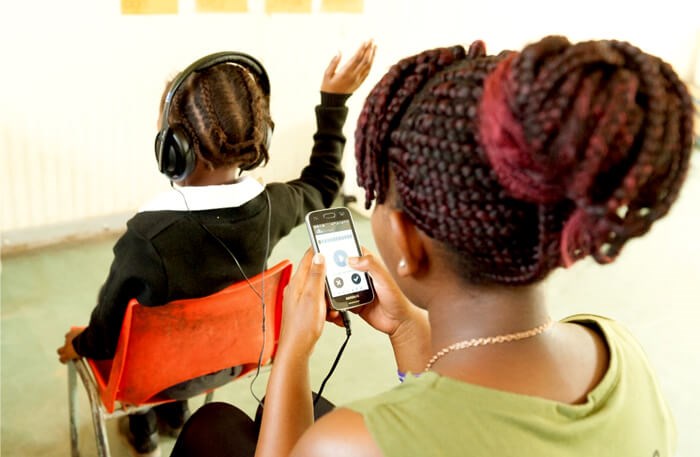Connected hearing healthcare can improve access to affordable hearing healthcare. DeWet Swanepoel discuss how innovative trends in connectivity and technology offer opportunities for novel and decentralised models of delivering high-quality hearing healthcare.
Megatrends in connectivity and technology have ushered in an era of digital transformation that is revolutionising the global healthcare industry. Connectivity through mobile networks now covers 99% of the global population, with greater mobile connectivity [1] associated with quality of life gains, as measured by the sustainable development goal index score [2]. At the same time, exponential growth in technologies are seeing supercomputers in the form of smartphones, in the hands of the majority of adults around the globe, largely irrespective of high or low and middle-income regions [3].
These trends are unlocking new ways to deliver hearing healthcare that can radically improve affordable access in a scalable manner [4,5]. This is particularly appealing in low and middle-income countries (LMICs), where 90% of persons with hearing loss reside and where services are typically unavailable [6,7]. With half a billion persons affected by disabling hearing loss and the associated costs of hearing loss totalling an estimated $750 billion annually, new ways of delivering services are essential. Traditional hearing healthcare has typically been very centralised and expensive and has required highly-skilled professional staff, therefore constituting significant barriers to accessible and affordable care. Connected technologies are uniquely positioned to counteract these barriers in ways that allow for decentralised access at a lower cost. Several examples are considered below.
Detection and triage
Smartphone apps using digits-in-noise testing have been released as national hearing screening apps (hearZA™ & hearScreenUSA™) with the ability to refer persons confirmed with hearing loss directly to hearing healthcare professionals, based on geolocation [5,8]. These apps can also include tools to support decision-making by encouraging persons with hearing loss to take action. For example, the hearZA™ app includes a quick interactive guide developed with the Ida Institute to help users reflect on why they may want to improve their hearing [9]. The World Health Organization also released a similar app, hearWHO [10] on world hearing day for free global use [5]. A new stimulus paradigm using antiphasic digits in noise (DIN) testing promises the ability to identify all types of hearing loss, including bilateral and unilateral sensorineural and conductive losses, in one three-minute test [11]. Combined with the more conventional diotic test procedure, this screening sequence can facilitate triaging hearing losses that require medical versus audiological investigation as first contact. Apart from smartphone apps, these services are also available on web and kiosk platforms to further decentralise access points.

Figure 1. Smartphone hearing screening in pre-schools facilitated by trained lay health workers.
Virtual hybrid clinics
Utilising virtual platforms for users searching for hearing care online, demonstrates potential to improve access through alternative and widely-used means [12]. A recent study established a non-profit research clinic using regionally targeted online marketing and a web-based digits-in-noise hearing screening. This was followed by virtual interactions and motivational tools with the option of a face-to-face diagnostic and hearing aid fitting appointment at home or in a public space. Lastly, an online rehabilitation programme and audiological support was provided [12]. Almost 90% of users access the virtual clinic from mobile devices of which one in four visitors take the hearing screening, two-thirds fail and one in five leave their contact details for virtual consultations. Users preferred WhatsApp, followed by email and phone call as the preferred communication [13]. Users who took up diagnostic and hearing aid trial services were between 35-101 years and reported satisfaction of clinic services that exceeded previous experiences, which most users already had [13].
Minimally-trained persons
Using smartphone audiometry apps with calibrated headphones (hearX group, Pretoria, South Africa), easy user interfaces, automated testing and advanced quality control, allows minimally-trained non-professionals to facilitate hearing screening in communities [14-17]. In a recent WHO Bulletin paper, we demonstrated that hearing and vision screening facilitated by trained laypersons for pre-school children in LMICs were within accepted screening programme performance indicators [14]. Cloud-based data management allows for remote surveillance of test operator quality, environmental noise compliance and sending text message results directly to parents with location-based referrals [14]. The total cost of the combined hearing and vision service, including operational and human resource expenses, was only $5.61 [14]. This model demonstrates the power of connected technologies to provide community-based hearing care, facilitated by trained laypersons, at low cost with the possibility to expand to include services such as vision.
Conclusion
Connected technologies are powerful enablers of health and wellbeing and hearing health is no exception. The technologies not only provide more affordable, mobile and easy-to-use point-of-care diagnostics but, with cloud integration, these technologies are allowing entirely new models of service delivery. These new models are demonstrating promise to reduce costs, decentralise access and improve quality control, surveillance and reporting.
References
1. The World Bank. Mobile network coverage, % pop.
https://tcdata360.worldbank.org/
indicators/entrp.mob.cov?country
=BRA&indicator=3403&viz
=line_chart&years=2012,2016
&indicators=944&compareBy=region
Last accessed September 2019.
2. GSMA Intelligence. 2018 Mobile industry impact report: Sustainable development goals.
www.gsmaintelligence.com/research/
?file=ecf0a523bfb1c9841147
a335cac9f6a7&download
Last accessed September 2019.
3. Wigginton C. Global mobile consumer trends: Second edition.
www2.deloitte.com/global/en/pages/
technology-media-and-telecommunications/
articles/gx-global-mobile-consumer-trends.html
Last accessed September 2019.
4. Bernstein L, Besser J, Maidment D, Swanepoel D. Innovation in the context of audiology and in the context of the internet. American Journal of Audiology 2018;27:376-84.
5. Swanepoel D, Smits C, De Sousa KC, Moore D. (in press). Mobile apps to screen for hearing loss: Opportunities and challenges. Bulletin of the World Health Organization.
6. World Health Organisation [WHO]. Multi-country Assessment of National Capacity to Provide Hearing Care. Geneva: Switzerland.
www.who.int/pbd/publications/
WHOReportHearingCare_Englishweb.pdf?ua=1
Last accessed September 2019.
7. World Health Organisation [WHO]. Deafness and Hearing Loss Factsheet. Geneva: Switzerland.
www.who.int/news-room/
fact-sheets/detail/deafness-and-hearing-loss
Last accessed September 2019.
8. De Sousa KC, Swanepoel D, Moore D, Smits C. A smartphone national hearing test - Performance and characteristics of users. American Journal of Audiology 2018;27:448 54.
9. Cox AF. New mobile app tests hearing and refers to hearing care professionals.
https://idainstitute.com/what_we_do/
news/blog/show/new-mobile-app
-tests-hearing-and-refers-to-hearing
-care-professionals/
Last accessed September 2019.
10. World Health Organisation [WHO]. Deafness prevention.
www.who.int/deafness/hearWHO/en/
Last accessed September 2019.
11. De Sousa KC, Swanepoel D, Moore, et al. Improving Sensitivity of the Digits-in-Noise Test Using Antiphasic Stimuli. Ear and Hearing 2019.
12. Ratanjee-Vanmali H, Swanepoel D, Laplante-Lévesque A. Characteristics, behaviours and readiness of persons seeking hearing healthcare online. International Journal of Audiology 2019;58(2):107-15.
13. Ratanjee-Vanmali H, Swanepoel D, Laplante-Lévesque A. (Submitted). Patient experience and satisfaction using virtual and face-to-face hearing health services.
14. Eksteen S, Launer S, Kuper H, et al. Hearing and vision screening for preschool children using mobile technology, South Africa. Bulletin of the World Health Organization 2019;97:672-80.
15. Suen JJ, Bhatnagar K, Emmett SD, et al. Hearing care across the life course provided in the community. Bulletin of the World Health Organization 2019;97:681-90.
16. Yousuf Hussein S, Swanepoel D, Mahomed-Asmail F, Biagio de Jager L. Community-based hearing screening for young children using an mHealth service-delivery model. Global Health Action 2018;11(1):1467077.
17. Van Wyk T, Mahomed-Asmail F, Swanepoel D. Supporting hearing health in vulnerable populations through community care workers using mHealth technologies. International Journal of Audiology 2019;58:790-7.
Declaration of Competing Interests: De Wet Swanepoel has a relationship with the hearX Group that includes equity and consulting.






